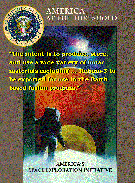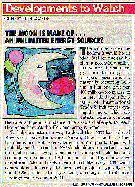NEEP602 Course Notes (Fall 1997)
Resources from Space
The Significance of 3He
Professor G. L. Kulcinski
November 5, 1997
If the use of 3He as a fusion fuel is so great, why has it not been done before?
From lecture 27, we have seen that the IEC concept could solve the physics issues facing the "burning" of advanced fusion fuels, but what about 3He resources?
It is worthwhile noting that when burned with 0.67 kg of D:
The known present reserves of 3He in the World come from
From Figure 2 it can be seen that only ~ 300-500 kg of 3He could be practically available by the year 2000, mostly from the 3He collected by processing thermonuclear weapons.
On the other hand, this amount of 3He is enough to build and operate all the test facilities that would be needed in the next few decades up to and including a ~ 3-500 MWe fusion power plant or an orbiting 200 MWe power plant. The ultimate problem comes in providing the fuel for a 3He fusion economy. In that situation, tonnes (not kg) of 3He are required.
Where Can We Get Enough 3He?

From our previous lectures (particularly #13)
we have seen that tonnage quantities of 3He
have been identified on the lunar surface. Estimates not put the 3He resource at ~ 1 million tonnes.
Where Can We Get Enough 3He?
 |
From our previous lectures (particularly #13) we have seen that tonnage quantities of 3He have been identified on the lunar surface. Estimates not put the 3He resource at ~ 1 million tonnes. |
How Much Energy is There in Lunar 3He?
What Do Others Say About 3He?
Several research groups, governmental administrators, and journalists have made statements about the significance of 3He to our future (White, 1996). A few of these quotes are given below.
 |
 |
 |
 |
References
Kulcinski, G. L., Emmert, G. A., Blanchard, J. P., El-Guebaly, L. A., Khater, H. A., Maynard, C. W., Mogahed, E. A., Santarius, J. F., Sawan, M. E., Sviatoslavsky, I. N., Wittenberg, L. J., 1992b, "Safety and Environmental Characteristics of Recent D-3He and DT Tokamak Power Reactors", Fusion Technology, Vol. 21, No. 3, Part 2B, p. 1779.
Kulcinski, G. L., 1993, "History of Research on 3He Fusion", University of Wisconsin WCSAR-TR-AR3-9307-3, p. 9, [Presented at the Second Wisconsin Symposium on Helium-3 and Fusion Power; Proceedings of a Symposium held in Madison, WI, 19-21 July 1993].
White, S. W., 1996, "A Current Bibliography of Helium-3 Research", University of Wisconsin Report UWFDM-1003, January 1996.
Wittenberg, L. J. Santarius, J. F. and Kulcinski, G. L.,1986, "Lunar Source of He-3 for Commercial Fusion Power", Fusion Technology, 10, p.167.
Representative Questions
1.) How much tritium would one have to have to provide the 3He fuel for an annual U. S. Electrical Demand of 500 GWe?
2.) What is the total thermal energy associated with 1,000,000 metric tonnes of 3He burned with D? What is the equivalent amount of barrels of oil?
 |
|
University of Wisconsin Fusion Technology Institute · 439 Engineering Research Building · 1500 Engineering Drive · Madison WI 53706-1609 · Telephone: (608) 263-2352 · Fax: (608) 263-4499 · Email: fti@engr.wisc.edu |
Copyright © 2003 The Board of
Regents of the University of Wisconsin System.
For feedback or accessibility issues, contact
web@fti.neep.wisc.edu.
|

 Figure
2
Figure
2






